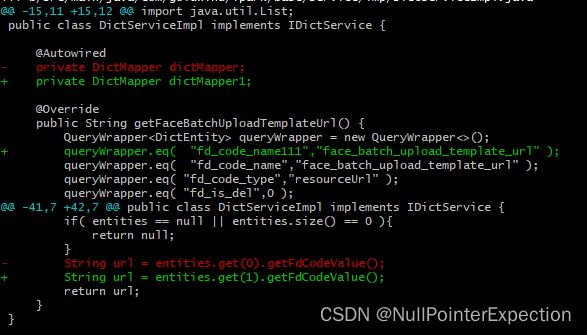手动实现 git 的 git diff 功能
这是 git diff 后的效果,感觉挺简单的,不就是 比较新旧版本,新增了就用 "+" 显示新加一行,删除了就用 "-" 显示删除一行,修改了一行就用 "-"、"+" 显示将旧版本中的该行干掉了并且新版本中增加了一行,即使用 "删除" + "新增" 操作代替 "修改" 操作,然后就用
然后我们写的测试代码如下:
import com.goldwind.ipark.common.util.MyStringUitls;
import org.apache.commons.text.similarity.LevenshteinDistance;
import java.io.BufferedReader;
import java.io.FileReader;
import java.util.ArrayList;
import java.util.List;
public class MyDiffTest {
public static void main(String[] args) {
List lines_old = loadTxtFile2List("C:\\E\\javaCode\\git\\outer_project\\guodiantou\\gdtipark-user-servie\\src\\main\\java\\com\\goldwind\\ipark\\base\\test\\DemoClass1.java" );
List lines_new = loadTxtFile2List("C:\\E\\javaCode\\git\\outer_project\\guodiantou\\gdtipark-user-servie\\src\\main\\java\\com\\goldwind\\ipark\\base\\test\\DemoClass2.java");
// lines1的起始行和 lines2 的起始行做映射
// 扫描旧版本中的每一行
int size = lines_old.size();
for( int i=0;i loadTxtFile2List(String filePath) {
BufferedReader reader = null;
List lines = new ArrayList<>();
try {
reader = new BufferedReader(new FileReader(filePath));
String line = reader.readLine();
while (line != null) {
// System.out.println(line);
lines.add( line );
line = reader.readLine();
}
return lines;
} catch (Exception e) {
e.printStackTrace();
return null;
} finally {
if (reader != null) {
try {
reader.close();
} catch (Exception e) {
e.printStackTrace();
}
}
}
}
} 其中用到的2个新旧版本的文本如下:
DemoClass1.java:
import com.goldwind.ipark.common.exception.BusinessLogicException;
import lombok.extern.slf4j.Slf4j;
import org.apache.commons.text.similarity.LevenshteinDistance;
@Slf4j
public class DemoClass1 {
private static final LevenshteinDistance LEVENSHTEIN_DISTANCE = LevenshteinDistance.getDefaultInstance();
public static String null2emptyWithTrim( String str ){
if( str == null ){
str = "";
}
str = str.trim();
return str;
}
public static String requiredStringParamCheck(String param, String paramRemark) {
param = null2emptyWithTrim( param );
if( param.length() == 0 ){
String msg = "操作失败,请求参数 \"" + paramRemark + "\" 为空";
log.error( msg );
throw new BusinessLogicException( msg );
}
return param;
}
public static double calculateSimilarity( String str1,String str2 ){
int distance = LEVENSHTEIN_DISTANCE.apply(str1, str2);
double similarity = 1 - (double) distance / Math.max(str1.length(), str2.length());
System.out.println("相似度:" + similarity);
return similarity;
}
}DemoClass2.java:
import com.goldwind.ipark.common.exception.BusinessLogicException;
import lombok.extern.slf4j.Slf4j;
import org.apache.commons.text.similarity.LevenshteinDistance;
@Slf4j
public class DemoClass2 {
private static final LevenshteinDistance LEVENSHTEIN_DISTANCE = LevenshteinDistance.getDefaultInstance();
private static final LevenshteinDistance LEVENSHTEIN_DISTANCE1 = LevenshteinDistance.getDefaultInstance();
private static final LevenshteinDistance LEVENSHTEIN_DISTANCE2 = LevenshteinDistance.getDefaultInstance();
public static String null2emptyWithTrim( String str ){
if( str == null ){
str = "";
}
str = str.trim();
return str;
}
public static String requiredStringParamCheck(String param, String paramRemark) {
param = null2emptyWithTrim( param );
if( param.length() == 0 ){
String msg = "操作失败,请求参数 \"" + paramRemark + "\" 为空";
log.error( msg );
throw new BusinessLogicException( msg );
}
return param;
}
public static double calculateSimilarity( String str1,String str2 ){
int distance = LEVENSHTEIN_DISTANCE.apply(str1, str2);
double similarity = 1 - (double) distance / Math.max(str1.length(), str2.length());
System.out.println("相似度:" + similarity);
return similarity;
}
}DemoClass2.java 相较于 DemoClass1.java 的区别是 "public class" 后面的类名不同,"private static final LevenshteinDistance LEVENSHTEIN_DISTANC..." 多复制了2行并改了名称,然后运行后显示差别如下:
import com.goldwind.ipark.common.exception.BusinessLogicException;
import lombok.extern.slf4j.Slf4j;
import org.apache.commons.text.similarity.LevenshteinDistance;
@Slf4j
- public class DemoClass1 {
+ public class DemoClass2 {
private static final LevenshteinDistance LEVENSHTEIN_DISTANCE = LevenshteinDistance.getDefaultInstance();
-
+ private static final LevenshteinDistance LEVENSHTEIN_DISTANCE1 = LevenshteinDistance.getDefaultInstance();
- public static String null2emptyWithTrim( String str ){
+ private static final LevenshteinDistance LEVENSHTEIN_DISTANCE2 = LevenshteinDistance.getDefaultInstance();
- if( str == null ){
+
- str = "";
+ public static String null2emptyWithTrim( String str ){
- }
+ if( str == null ){
- str = str.trim();
+ str = "";
- return str;
+ }
- }
+ str = str.trim();
-
+ return str;
- public static String requiredStringParamCheck(String param, String paramRemark) {
+ }
- param = null2emptyWithTrim( param );
+
- if( param.length() == 0 ){
+ public static String requiredStringParamCheck(String param, String paramRemark) {
- String msg = "操作失败,请求参数 \"" + paramRemark + "\" 为空";
+ param = null2emptyWithTrim( param );
- log.error( msg );
+ if( param.length() == 0 ){
- throw new BusinessLogicException( msg );
+ String msg = "操作失败,请求参数 \"" + paramRemark + "\" 为空";
- }
+ log.error( msg );
- return param;
+ throw new BusinessLogicException( msg );
- }
+ }
-
+ return param;
- public static double calculateSimilarity( String str1,String str2 ){
+ }
- int distance = LEVENSHTEIN_DISTANCE.apply(str1, str2);
+
- double similarity = 1 - (double) distance / Math.max(str1.length(), str2.length());
+ public static double calculateSimilarity( String str1,String str2 ){
- System.out.println("相似度:" + similarity);
+ int distance = LEVENSHTEIN_DISTANCE.apply(str1, str2);
- return similarity;
+ double similarity = 1 - (double) distance / Math.max(str1.length(), str2.length());
- }
+ System.out.println("相似度:" + similarity);
- }
+ return similarity;
为啥???
如上两张图片,旧版本的第10行和新版本的第10行对应,从直观上看新版本的第11、12行是在旧版本的第10行和第11行之间插进去的,但是程序并不这么认为,它会认为将旧版本的第11行的空白行修改为了新版本的 “private static final LevenshteinDistance LEVENSHTEIN_DISTANCE1 = LevenshteinDistance.getDefaultInstance();” 为什么我们人眼会这么直观的感觉到 新版本的 第11、12行时插进去的,因为我们比较了新旧版本的第7、8、9、10行都差不多,旧版本的11~27行和新版本的 13~29行都差不多,所以自然而然的认为新版本的11、12行是直接插进去的,那么现在我们就来算法实现吧!( ps:前文中的 “差不多” 是差几多?是完全equals 还是很像?”其实这里可以设置一个阈值,使用求字符串的相似度算法求出相似度,网上有现成的类库求相似度,自己也可以使用动态规划写一个简单的字符串相似度算法 )
感觉恰当的算法的执行过程应该是这样的:
新旧版本各维持一个行号游标:index_old、index_new,最开始这两个游标相同,越往后可能不同,但是他们表示的行的内容应该是应该相似的,因为新版本的修改会导致内容越来越 “错位”。假设我们从上面2张图片的第7行开始描:
1. 最开始 index_old = index_new = 7,算法检测到新旧版本的第7行的内容相同( 后面我们就尽量用伪代码表示,就不说这么多啰里啰嗦的话了 ),即 lines_old[ 7] = lines_new[ 7]。
2. index_old++,index_new++,都变为8,算法检测到 lines_old[ 8 ] != lines_new[ index_new ],并且他们的相似度很高,所以算法判断新版本的第8行相较于旧版本的第8行是做了修改操作。
3. index_old++,index_new++,都变为9,算法检测到 lines_old[ 9 ] = lines_new[ 9 ]。
4. index_old++,index_new++,都变为10,算法检测到 lines_old[ 10 ] = lines_new[ 10 ]。
5. index_old++,index_new++,都变为11,算法检测到 lines_old[ 11 ] != lines_new[ 11 ],并且这两行的文本内容及不相似,所以判断新版本是在旧版本的第11行插入了一行 “private static final LevenshteinDistance LEVENSHTEIN_DISTANCE1 =LevenshteinDistance.getDefaultInstance();”,所以此时旧版本的第11行就和新版本的第11行对应不上了,而是和新版本的第12行做对应。
6. index_old 不变,index_new++,index_old 还是11,index_new 变为 12,即旧版本的第11行要和新版本的第12行做对应,就像找老婆一样,旧7和新7结为了夫妻,旧8和新8结为了夫妻( 虽然有一点点的裂痕,但不打紧 ),新9和新9结为了夫妻,...,所以旧11也要在新版本中找到一个新x作为自己的伴侣,本来已经找到了一个新11,但是发现新11和自己三观差别很大,根本合不来,所以pass掉,继续找,现在发现了下一个相亲对象 新12,发现lines_old[ 11 ] 和 lines_new[ 12 ] 相似度还是差别很大,所以算法判断新版本又插入了一个新行 “private static final LevenshteinDistance LEVENSHTEIN_DISTANCE2 = LevenshteinDistance.getDefaultInstance();”。
7. index_old 不变,index_new++,index_old 还是11,index_new 变为 13,因为 lines_old[ 11 ] = lines_new[ 13 ],所以 旧11 很幸运的找到了自己的伴侣 新13,。
8. index_old++,index_new++,index_old变为12,index_new变为14,因为 lines_old[ 12 ] = lines_new[ 14 ],所以此步未检测到变化。
...
改进后的测试代码如下:
todo

